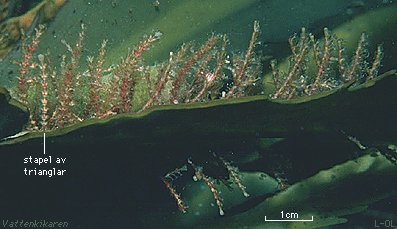|

Distribution in scandinavian waters
|
Maximum length: 5 cm.
Appearance: In this sparsely branched colony,
the individuals are attached in pairs. In natural size it looks as though
the stem is composed of small triangles piled on top of each other.
Usually dark brown in colour, but when the light shines through the
chitin casing the colour can change to a golden lustre. The picture
above depicts a colony of dynamena pumila that has been coloured
by red algae. Dynamena pumila is self-luminescent.
Because this species has a very characteristic appearance,
it is easily recognizable. Compare with other
hydroids, such as the club-headed
hydroid.
Depth: From sea-level and a few metres down.
Environment: This hydroid attaches
itself readily to the older parts of brown algae. The picture above
depicts a colony attached to toothed
wrack.
Misc: Dynamena pumila catches minute plankton particles
with its tentacles. The hydroid itself can be assaulted
by among other things, opisthobranchs and sea-spiders..
Classification: Dynamena pumila belongs to the group hydroids
under the cnidarians.
|


